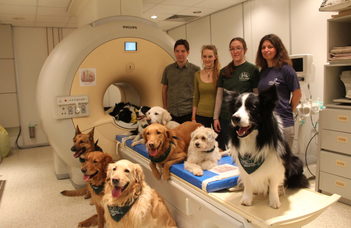Are dog brains into human faces?

Researchers of the Department of Ethology of Eötvös Loránd University, Hungary, investigated neural processes for face perception in dogs using functional magnetic resonance imaging (fMRI). In this study dogs’ brain did not show a different reaction when it was presented with human faces compared to scrambled versions of the same faces. These results suggest that the dog brain is not as specialized as the human brain when it comes to face processing. The study will be published in Frontiers in Behavioral Neuroscience on the 3rd of March.
“Faces represent a special category for humans, their processing differs from everyday objects (e.g. it is disproportionately more difficult for us to recognise faces upside down than an object) and their neural processing has its own specialized pathway. This is understandable if you think about how much human communication depends on the face alone, while animals in general tend to use their whole body, e.g. think about how a dog’s raised hair can be an important part of its communication. Whether faces in isolation represent a special category for dogs is controversial, as much depends on the exact conditions of the experiments and the researchers’ interpretation” — says Dóra Szabó, the first author of the study.
The researchers used fMRI with the participation of family dogs who previously underwent in a special, reward-based training for months to be measurable while awake and unrestrained in the brain scanner.
To investigate dogs’ neural response toward faces scientists conducted two experiments. In the first, they showed the dogs a live person’s face (only the head contour, thus the ears, chin and hair was not visible) and compared the dogs’ neural response to a monochrome surface of the same oval shape. In the second experiment they applied a more strict control, by comparing live faces and photos of faces with scrambled images of the photos. This way they ensured that the color, brightness and complexity of the images was also similar.
They found that while in the first experiment, multiple brain regions showed higher activity for faces, this preference disappeared in the second experiment, when they controlled for low-level visual characteristics.
“This was the first neuroimaging study which investigated this phenomenon while controlling for the shape of the stimuli and other low-level visual features. The findings are in line with previous behavioural studies, which also reported that dogs cannot recognize their owners based on their inner faces without specific training. Does this mean that dogs cannot read faces? Not at all! Dogs are well known to react to and extract information from human gaze and facial expressions. Our results mean that we did not find a specialized face area in dogs which would be specifically sensitive for faces. Dogs may not rely on a highly specialized neural network to excel at face processing” — summarizes Attila Andics, senior author of the study.
This study was published in Frontiers in Behavioral Neuroscience titled “On the Face of It: No Differential Sensitivity to Internal Facial Features in the Dog Brain”, written by Dóra Szabó, Anna Gábor, Márta Gácsi, Tamás Faragó, Enikő Kubinyi, Ádám Miklósi and Attila Andics. This research was funded by the European Research Council (ERC), the Hungarian Academy of Sciences (’Lendület’ Program), National Research, Development and Innovation Office, the Ministry of Human Capacities, the Hungarian Brain Research Program, and the Eötvös Loránd University (ELTE).
Link to the article: https://www.frontiersin.org/articles/10.3389/fnbeh.2020.00025/

